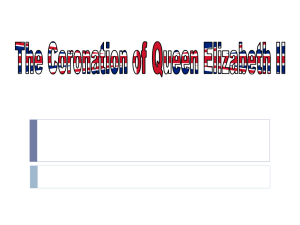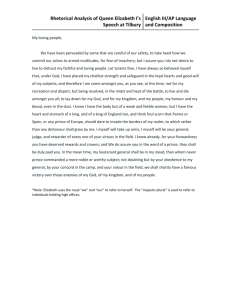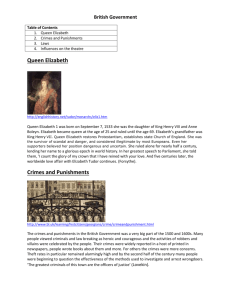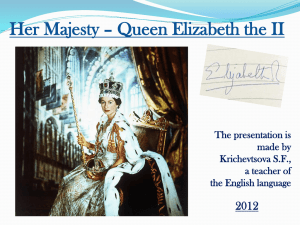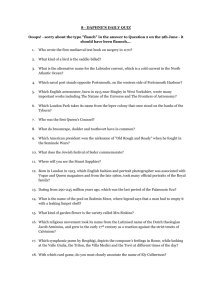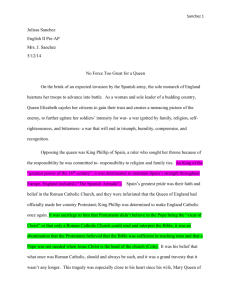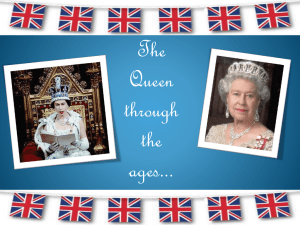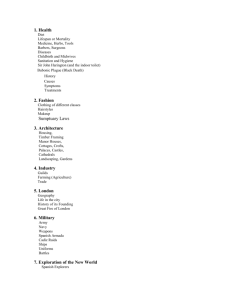History
advertisement
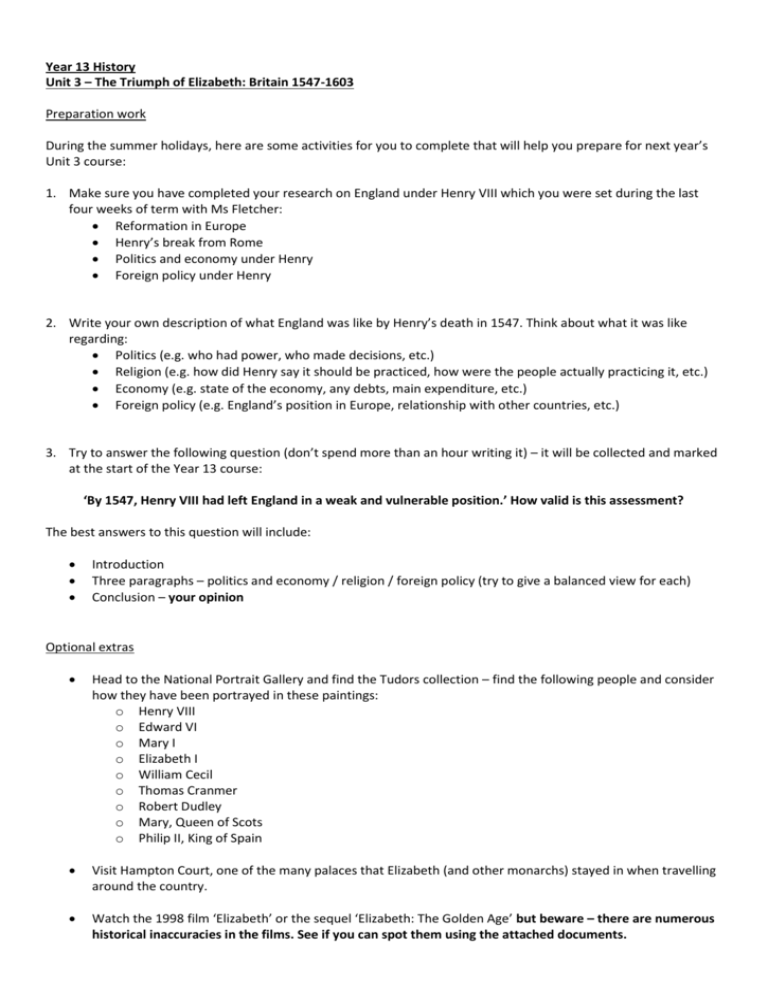
Year 13 History Unit 3 – The Triumph of Elizabeth: Britain 1547-1603 Preparation work During the summer holidays, here are some activities for you to complete that will help you prepare for next year’s Unit 3 course: 1. Make sure you have completed your research on England under Henry VIII which you were set during the last four weeks of term with Ms Fletcher: Reformation in Europe Henry’s break from Rome Politics and economy under Henry Foreign policy under Henry 2. Write your own description of what England was like by Henry’s death in 1547. Think about what it was like regarding: Politics (e.g. who had power, who made decisions, etc.) Religion (e.g. how did Henry say it should be practiced, how were the people actually practicing it, etc.) Economy (e.g. state of the economy, any debts, main expenditure, etc.) Foreign policy (e.g. England’s position in Europe, relationship with other countries, etc.) 3. Try to answer the following question (don’t spend more than an hour writing it) – it will be collected and marked at the start of the Year 13 course: ‘By 1547, Henry VIII had left England in a weak and vulnerable position.’ How valid is this assessment? The best answers to this question will include: Introduction Three paragraphs – politics and economy / religion / foreign policy (try to give a balanced view for each) Conclusion – your opinion Optional extras Head to the National Portrait Gallery and find the Tudors collection – find the following people and consider how they have been portrayed in these paintings: o Henry VIII o Edward VI o Mary I o Elizabeth I o William Cecil o Thomas Cranmer o Robert Dudley o Mary, Queen of Scots o Philip II, King of Spain Visit Hampton Court, one of the many palaces that Elizabeth (and other monarchs) stayed in when travelling around the country. Watch the 1998 film ‘Elizabeth’ or the sequel ‘Elizabeth: The Golden Age’ but beware – there are numerous historical inaccuracies in the films. See if you can spot them using the attached documents. Elizabeth (1998) – Historical Inaccuracies 1. When Elizabeth was taken to the Tower in 1554, Robert Dudley was already there for his part in his father's attempt to take the throne for his daughter-in-law, Lady Jane Grey. 2. The Duke of Norfolk was not a key character in English political history until Elizabeth had been on the throne for some years, and it was 14 years into the reign before he was executed for treason. 3. Francis Walsingham likewise was not a key figure in English politics until the second decade of the Queen's reign. He began his political career as a servant of William Cecil and in the early 1570's was recalled from France to be made Secretary of State. 4. Sir William Cecil was only in his thirties when Elizabeth became Queen, and remained her chief advisor for 40 years. Elizabeth never allowed him to retire. He was made Lord Burghley 13 years into the reign. 5. It is unlikely that Robert Dudley and the Queen had a sexual relationship, for various reasons, and their love affair had not begun at the time of her coronation. In all probability, the Queen was the virgin she claimed to be. 6. Mary of Guise was not killed by Francis Walsingham, but died of natural causes. Walsingham was not homosexual. Neither did he murder a young boy. Walsingham was happily married and a very religious man. 7. France did not send a poisoned dress to kill the Queen, and none of her maids of honour were murdered. 8. The cross dressing Duke of Anjou did not come to England. It was his brother who came to England 20 years later, Francis, Duke of Alencon. He was not a cross dresser, and the Queen seriously considered marrying him. 9. The assassination attempt against Elizabeth that occurs on the river during the pageant did not take place until 1578, and then in very different circumstances. It was not an assassination attempt at all, but a salute to the Queen that went wrong. No one was killed. 10. Robert Dudley did not hide his first marriage from the Queen. Elizabeth knew that he was married, having attended the wedding in 1550. Legend has it that 20 years later he hid his marriage to Lettice Knollys Devereux, Dowager Countess of Essex, from the Queen, but in recent years the truth of this tale has been questioned. 11. Robert Dudley was never involved in a treasonous plot to kill the Queen. He was her closest friend throughout her life, and did all that he could to preserve her life. He was involved in the plan for Norfolk to marry Mary, Queen of Scots, but this was not to begin with a plot to kill Queen Elizabeth. When it turned that way, Robert abandoned it immediately and told the Queen exactly what was going on. It is possible that he was actually working on the Queen's behalf, and he certainly lost no favour over the incident. Norfolk was not executed for his involvement in this plot, but for a plot to assassinate the Queen formulated by Ridolfi. Robert had no involvement in this whatsoever. 12. The Earl of Sussex was never executed for treason. He was a devoted subject of the Queen and remained so until his death. 13. Kat Ashley was a lot older than Elizabeth, and became her governess when Elizabeth was only four years old. She was the only mother-figure Elizabeth knew, and died in 1565 when she was in middle age. 14. Queen Elizabeth did not decide early in her reign to cut off her hair and paint her face to make herself like the Virgin Mary. It is not until about 20 years into her reign, when it is certain she would not marry, that the legend of the Virgin Queen really begins to emerge. In 1562, the Queen was very ill with small pox, and she may have used heavy cosmetics to hide the faint scars on her face left by the disease. Wearing wigs was merely fashionable. 15. Elizabeth and Robert remained close throughout their lives, and contrary to the postscript of the movie, she saw him in private many times. For several years she contemplated marrying him, but it was not politically expedient to do so. When he died in 1588, the Queen was devastated. There is no evidence that she whispered his name on her death bed. She was probably beyond speech at that time, her illness being an ulcerated throat. 16. Most of the film's interiors and exteriors were two or three centuries out of date, reflecting more what life may have been like in the 12th or 13th centuries rather than the 16th. The Tudor monarchs lived in glorious palaces such as Nonsuch, Hampton Court, Whitehall, and Greenwich. The interiors and exteriors in the film Shakespeare in Love give a better example of how the Tudor nobility lived. Elizabeth: The Golden Age (2007) – Historical Inaccuracies 1. The Babington Plot, one of the conspiracies to assassinate Elizabeth I, was portrayed in the movie as having been carried out with the shooter coming face to face with the queen and the plot only failed because the gun used for the assassination was unloaded. The real Babington Plot was discovered before it was attempted and the conspirators sentenced to death. 2. There’s no Robert Reston, the Jesuit who was ordered by Philip II to do the duty God gave him, in history. He could be John Ballard, who was also a Jesuit and a conspirator in the Babington Plot. However, he was killed off (wrongly) in the first film, and so Reston was created to take his place in history. 3. In 1588, Philip II’s daughter Infanta Isabel was actually 21, despite being portrayed by a child in the film. 4. Francis Drake was the leader of the English fleet who went toe-to-toe against the Spanish forces and defeated them. Walter Raleigh played a smaller role in the Armada, manning costal defenses in Devon. 5. The English fleet was not severely outnumbered and outgunned by the Spanish Armada. In the main battle of Gravelines, the English ships outnumber the Spanish. 6. The use of fire-ships by the English fleet was not an act of desperation as portrayed in the film, but an act of brilliant naval tactics. The fire-ship attacks forced the Spanish fleet to cut their anchors (which troubled them at the later stage of their campaign) and break their formation and positioned themselves against the wind. This enabled the faster English ships to target the Spanish ships. 7. It was not the severe storm that battered the Spanish Armada and saved England. The English Navy used better naval tactics and strategy. 8. The storm that wrecked the Spanish Armada came later when they were defeated by the English navy at the Battle of Gravelines. Since the English Channel was secured by the English fleet, the Spanish fleet had no choice but to sail around Scotland and Ireland. That is where the storm battered them. With their anchors cut before the battle of Gravelines, Spanish ships were mercilessly hammered against the rocky coasts of Ireland. 9. The locations in the film, including the Cathedrals and the bare stone walls, are about 300-400 years out of date. 10. The costumes in the film are also inaccurate. Anyone who attended court would have had to have been formally dressed. Raleigh would never have been able to have an audience with the queen whilst wearing an open-necked shirt. 11. Elizabeth liked Raleigh but was never in love with him. She would flirt to win favour, but there is no evidence of anything serious between them. Raleigh did have an affair with Bess Throckmorton, but she did not become pregnant until 1591, three years after the Armada defeat. 12. Important figures in the story, such as Burghley, Leicester and Drake are sidelined, despite them having a large impact upon Elizabeth and the war with Spain. Raleigh is given a greater role than actually occurred and John Dee didn’t return from travelling until 1589. 13. Mary, Queen of Scots grew up in France and French was her native language. If she spoke English, it would have been with a French accent, not Scottish. She was also placed under house arrest in 1568 when she fled to England, and Elizabeth’s ministers attempted to persuade her to execute Mary right up until 1587. 14. When Elizabeth addresses the troops at Tilbury in full armour, she would have been about 55 years old. Later, there is no evidence to suggest that she stood on a clifftop in her nightie, staring at the Armada burning. In fact, it is likely that she would have been in London at this time. 15. By 1585, Elizabeth’s marriage negotiations with Archduke Charles had come and gone. Since then, she had courted two French matches, Henry, Duke of Anjou (portrayed too early in the first film) and Francis, Duke of Alencon. It is highly unlikely that Charles would have still desired Elizabeth at this time. 16. Likewise, Erik of Sweden ended his hopes of marrying Elizabeth by 1560, when he became King of Sweden. By 1568, he had been deposed from the throne and died in captivity in 1577. 17. Elizabeth had increasingly forced her subjects to become Protestant, increasing anti-Catholic laws through the 1580s and forcing those who didn’t attend Protestant services to pay fines. Although she was not as strict as previous monarchs, she still wanted her subjects to conform and punished those who did not.

